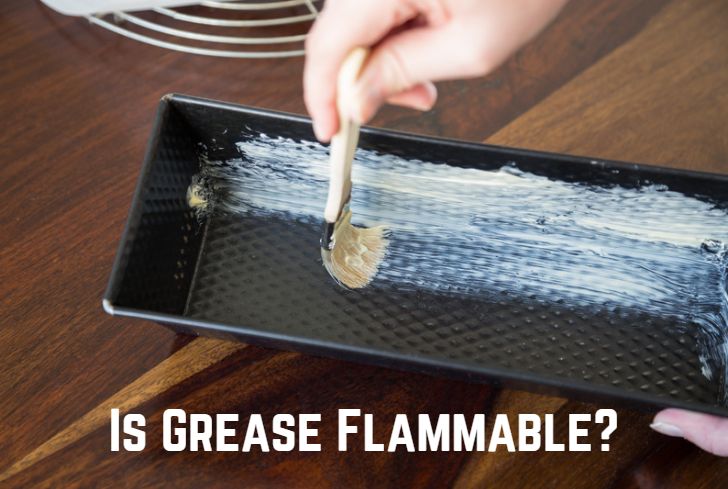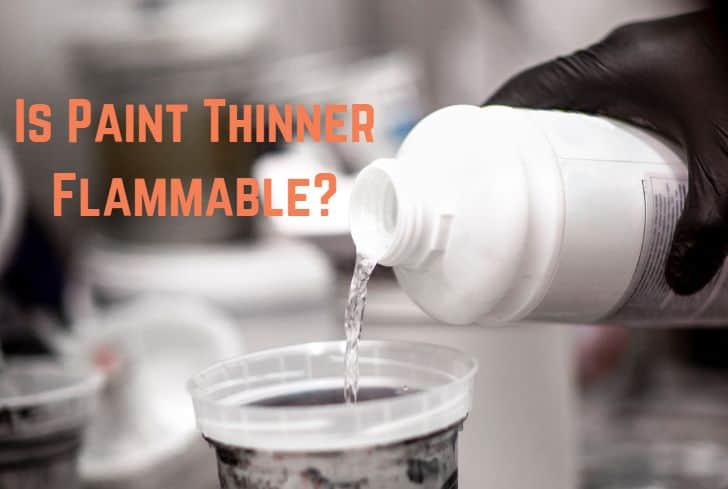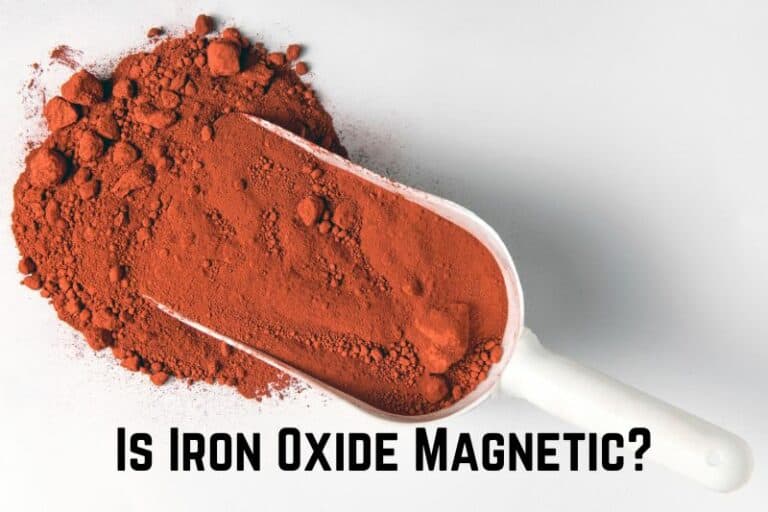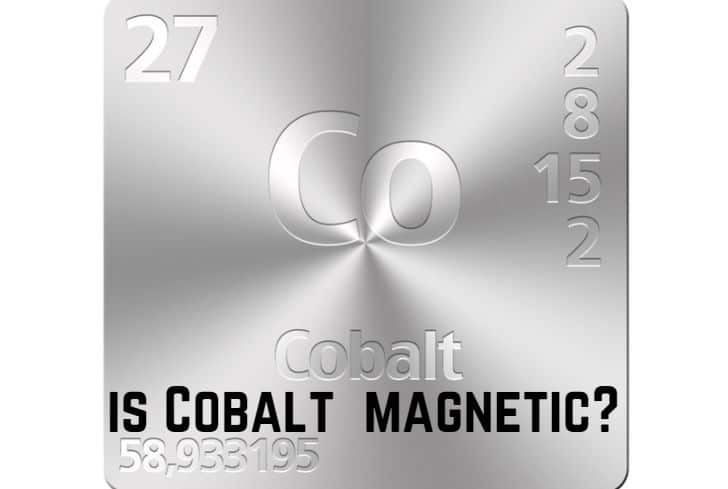Is Grease Flammable? (No…)

Even though most people enjoy cooking, there are some potential risks. Most kitchens contain flammable oils that can easily ignite a fire. Most people should know that the grease created when oil splashes on a pan or burner can be hazardous. But is grease flammable?
In this article, we will provide an answer to that question. But first, let’s define grease and discuss its flash point and safety for burning. You will also discover whether butter and bacon grease is flammable. Finally, we inform you of the heat a grease fire can reach and whether you can use water to put off one.
Read: Is Borax Flammable? (Is It Safe to Burn in Fire?)
What is Grease?
There are two types of grease. There is lubricating grease, which is a mixture of a liquid and a thickener. Due to its thick nature, it is best for sealing pipe leaks. Emulsifying soap (metallic elements such as aluminum, Lithium, or sodium reacted with a fatty acid) creates lubricant grease. Manufacturers also add mineral and vegetable oils to the soap.
0-30% thickener, 65–95% base oils, and 0–10% additives make up lubricating grease. These elements give the grease a semi-solid structure. The base oil and additives influence the lubricating grease’s flow. What binds the two together is the thickener.
The second type of grease is mainly a residue of animal cooking fats. It often accumulates in pans or ovens if you don’t do cleaning correctly. Most people use it to season food or salads. You can apply grease on pans or skillets to prevent food particles from sticking while cooking.
The flammability of cooking grease exceeds that of lubrication grease. While lubrication grease lacks fuel and oil, cooking grease does contain fat and oil. Atoms of carbon and hydrogen combine to form a hydrocarbon chain in fat. The chains vibrate until they ignite as the fat heats.
Is Grease Flammable or Non-flammable?
Grease is non-flammable. It will only catch fire if a spark or an open flame is nearby. That is generally true whether you are using cooking fat or lubricant grease. But, lubricant grease may have additional ingredients like alcohol that make it more flammable. But for it to ignite, there must still be an open flame nearby.
Most lubricating greases don’t ignite below certain temperatures, so they are considered non-flammable. They are not regarded as fire threats when working with them because they don’t burn as quickly as cooking greases. When enough heat and oxygen are applied, lubricant greases will burn as petroleum byproducts.
However, because each lubricating grease has a unique set of characteristics, it is essential to consult the material data safety sheet. Most lubricating greases use synthetic lubricants made from hydrocarbons or mineral oil generated from petroleum.
Is Bacon Grease Flammable?
Bacon grease is not flammable but is combustible. The smoke point of bacon grease is 450°F (232°C). However, it ignites at the flashpoint of 500°F (260°C). Non-flammable substances have a flashpoint above 212°F (100°C). The free fatty acids in the bacon grease start to burn off and smoke at the smoke point. The bacon fat will catch fire if the heat increases further.
You get bacon grease by melting bacon fat and allowing it to cool and solidify. While you fry your bacon and neglect to clean the pan, the grease will collect outside the pan. Using the same pan causes the grease to melt, smoke, and ignite when put on fire.
See: How To Use Bacon Grease As a Firestarter — Grill Hacks
When bacon grease reaches its autoignition temperature in an electric oven, it can catch fire even without a flame. Because of this, it’s crucial to periodically check your oven to ensure it’s not malfunctioning or overheating.
You should put off the heat or remove the dish from the oven if there is any evidence of smoke. When cooking, wipe up any grease drips onto the oven floor immediately.
What is the Flashpoint of Grease?
Grease has a variety of components, which affects its flash point. Nevertheless, grease typically has a flash point of 572 to 626 °F (300 to 330 °C). To be deemed flammable, a substance must have a flash point below 212°F (100°C). Grease can only catch fire in an open flame because of its higher flash point.
One of the grease’s most crucial properties is its flash point. The temperature at which grease starts to leak is known as the flash point. It implies that the thickening can no longer bind the grease’s base oils and additives. After grease reaches its flashpoint, it can no longer maintain the desired lubricating film.
Avoid leaving grease on hot surfaces until they have cooled down since grease can catch fire in as little as 30 seconds. An electric stove’s burner stays hot even after being turned off. Thus the heat source is not removed. In a gas stove, there is no rise in heat once the flame is out.
Is Butter Flammable?
Butter has a flash point of 302°F (150°C), making it non-flammable. Given that the fat comes from dairy products, it is surprising. Butter is less flammable since it contains water. Most water content in the butter evaporates during chemical processing. Buttercream, which has 18% water content, might not be as flammable as butter without water.
At 90–95°F (32–35°C), the butter melts, the water content evaporates, and just the milk proteins are left. The milk solids begin to evaporate from the liquid fats as the temperature reaches 185°F (85°C). Ultimately, it turns from yellow to light brown, golden brown, and dark brown. It takes between 15 and 30 seconds to complete this process.
Thankfully, butter is safe because its flash point exceeds our cooking temperature. The butter flash point is 302°F (150°C), which is much lower than the normal pan temperature of 248°F (120°C). However, as deep-frying and baking require temperatures higher than 320°F(160°C), you should avoid using butter.
Learn whether shea butter is flammable.
Is It Safe to Burn Grease?
Grease burning is unsafe because of how quickly a fire can spread. Keep in mind that extreme heat from a fire can harm both you and your property. A grease fire results when liquid grease is heated to a temperature where it might ignite. Stoves or other heat sources will be to blame for the high temperatures.
To stop grease from burning, you must frequently check the temperature of the cooking surface. Avoid leaving the cooking surfaces unattended for an extended period, just in case some grease splatters.
How Hot Can a Grease Fire Get?
Usually, cooking grease fire can get as hot as 500°F (260°C). On the other hand, grease lubricants can go even higher. Grease shouldn’t be one of your ingredients if you are baking or cooking at temperatures higher than that. You should also check your stoves, ovens, and pans for grease.
So what should you do to avoid a grease fire? Follow the tips below:
- Pan handles should be kept out of the way to prevent accidental tipping.
- If you see smoke when cooking using grease, immediately remove the stove.
- Use heavy pots with cover lids and a clip thermometer to check the temperature.
- To avoid grease spills, use pans with enough space.
- When cooking with grease, pay attention to the heat ratings and stay in the kitchen.
- Have a fire extinguisher close by, and keep your stove and oven clean.
Can You Put Out a Grease Fire With Water?
No! You should never attempt to put out a grease fire using water. The water won’t put out the fire; it will only spread it. Oil (or grease) and water don’t mix. Instead, the water redistributes the grease into tiny droplets. When the tiny drops scatter, the fire spreads. It becomes easier for the droplets to burn.
When you pour water on grease, it briefly submerges to the surface before steaming up. The steam pushes grease into the air, which reacts with oxygen to become quite explosive. Water boils at a temperature far lower than grease, so the water first sinks to the bottom.
Never put out a fire with water, flour, towels, or other clothing.
The steps listed below are the quickest and most effective techniques to put out the fire:
- Switch off the heat source. Avoid moving the pot to prevent grease from sputtering everywhere and igniting more flames.
- Cover the pot with a metal lid or any non-flammable materials. Fire cannot exist without oxygen and will eventually die out.
- You can use baking powder if it’s a small fire.
- You can use a Class B dry chemical fire extinguisher if the fire is still on. A fire extinguisher will release much pressure, so keep that in mind. To prevent tipping the pan over, use the fire extinguisher from a distance and move carefully toward the fire.
- Call 911 or the local fire department’s emergency number when the fire gets out of control.
Read: Is Olive Oil Flammable? (Can It Catch Fire?)
Conclusion
Although grease is combustible, it is not flammable. Butter, bacon grease, and lubricant grease have flashpoints considerably higher than the typical flash point for flammable materials. Grease burning is dangerous because of how quickly a fire can spread.
Don’t use water to put off a grease fire as it spreads further.






